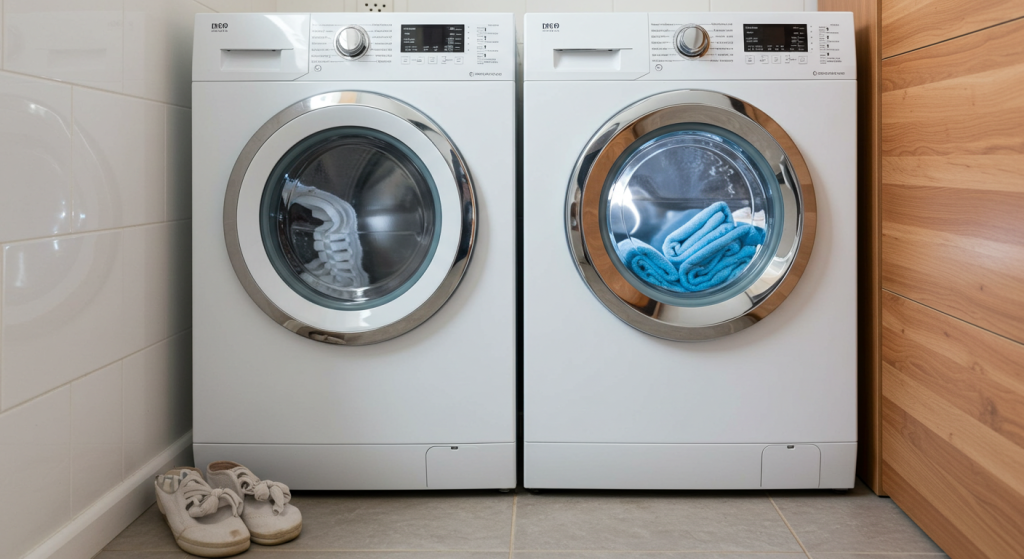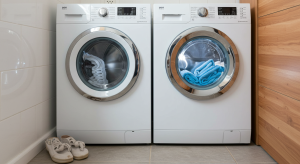Bring The Best Washing Machine In Your Home
The washing machine has revolutionized how people do laundry, and in many homes, it is now a must-have appliance. They are a quick and efficient means of cleaning clothes, which saves both time and effort. For a small apartment or a large household, choosing the right washing machine can greatly impact daily life, influencing convenience, energy usage and long-term savings.
You should analyze a few things (drum capacity, washing machine type, water and energy efficiency, smart features, etc.) before making a washing machine investment. The best option is based on the size of your household, how often you do laundry, space availability and budget.
This detailed guide helps buyers understand the different washing machine types, features, and modern-day technologies to make an informed purchase. Wide range of modern, innovative appliances with fully automatic washing, inverter-tech, smart connectivity, etc. are offering the best in terms of cleaning performance with higher savings in energy. To find the best washing machine that fits your needs and your budget.
NOTE: If you can’t find your answer then contact us best washing machine specialist for your all queries. We will guide you on the call and tell which washing machine is suitable according to your home, kitchen space, city, etc,
Several key factors come into play in choosing a washing machine:
- Capacity: The weight in kilograms, it refers to how much laundry can be washed in one cycle.
- Drum Size
- Spin Speed: More RPM, faster drying time.
- Wash Programs: Various options for different fabric types.
- Energy Efficiency: High star ratings save on electricity bills.
- Other Features: Smart control, fuzzy logic, steam function, and quick wash options improve customer experience.
Types of Washing Machines With Their Specs
Front Load Vs Top Load Washing Machines
[lt id=”1″]
Fully Automatic vs. Semi-Automatic Washing Machines
[lt id=”5″]
Size/Capacity Of The Washing Machine
Capacity affects efficiency in washing and must be commensurate with the number of family members in the house:
Kilogram (kg) Capacity:
- The weight referred to (e.g. 6 kg, 8 kg, 12 kg) is the dry weight of clothes a washing machine can wash in a single cycle.
Family Size Based Capacity Recommendations:
- 1-2 people → 6 kg or less: Suitable for individual or couple doing small loads of laundry.
- 3-4 people → 7-8kg: A medium-sized washing machine caters to the requirements of the average-sized family.
- 5+ people → 9-12 kg: For bigger families where there is a lot of laundry to do.
Drum Size
Drum size influences the washing method and comes in different materials:
Plastic:
- Affordable and lightweight.
- Not as durable as other materials.
- Can get depleted after a certain period of time, particularly with intense or protracted use.
Porcelain-Enamel:
- Offers more scratch-resistance than plastic, but can chip.
- Over time chipped enamel can lead to rusting and shorten the machine’s life.
- Durability and cost wise, a mid-range option.
Stainless Steel:
- The most rugged and economical choice.
- Hackers against rust, chipping, and wear over time.
- You are aware of the definition, characteristics, and strengths capable of managing a higher spin speed (RPM) and even larger loads.
- Other usage: Most washing machines as premium are designed for this.
Spin Speed (RPM)
- Spin speed is the amount of time that water is wrung from the clothes in the rinse cycle.
- Delicate fabrics (silk, wool) – 400-600 RPM
- These materials must be treated with care to avoid shrinkage or damage.
- The lower the RPM, the less agitation, and thus less creasing.
Cottons and synthetics – 800-1200 RPM:
- Basic fabrics like t-shirts, bed linens and polyester blends are okay with medium spin speeds.
- The gentle spin ensures efficient water removal without causing any undue wear to the fabric.
Heavy items (towels, jeans) – 1400+ RPM:
- Thick fabrics absorb more water, so they need a higher RPM to dry all this moisture.
- Makes sure towels, jeans and other similar clothes dry quickly after washing.
Why It Matters:
- Gentle fabrics shouldn’t be spun too high, as this could cause damage.
- Conversely, if you use too low an RPM when washing heavy clothes, they can retain excess water, which can lead to a longer drying time.
- Selecting the proper RPM enhances washing efficacy, preserves machinery, and reduces drying duration.
Wash Programs
Washing machines today are equipped with different programmes:
- Delicate Cycle: For delicates such as silk and lingerie. It features gentle agitation and slow spin speeds to resist damage.
- Cotton Wash: A regular cycle for day-to-day garments that provides a deep clean with moderate agitation over an extended cycle.
- Quick Wash: A quick-cycle program for lightly soiled items. It cuts down on washing time, typically finishing in 30 minutes or less.
- Wool Wash: This type is made for woolen garments, as it uses gentler agitation and cooler water temperatures to prevent shrinkage and damage.
- Heavy-Duty Wash: Ideal for extreme stains and hefty loads. It uses hotter water, more vigorous agitation, and longer cycles to get rid of tough dirt.
Dryer Options
Standalone Dryer:
- Need for a separate appliance for drying makes it space-consuming.
- Drys better since these are dedicated for clothes drying.
- Usually high drying capacity and fast drying times compared to combo machines.
Washer-Dryer Combo:
- A combined washer dryer unit, suitable for small homes or spaces with minimal room.
- Because it washes and dries clothes in one drum, it tends to take longer to dry clothes.
- Higher power consuming, and drying function is often not at all capable as that of over dryers.
Display & Controls
When it comes down to control options, things range from the simple manual knobs to sophisticated digital displays:
Manual Controls: Rotary knobs are easy and durable. Unlike their digital counterparts, they allow users to easily adjust the settings manually, making them easy to operate and reliable over time.
Digital Displays (LCD/LED) touchpads become more common, showing added features like timers, time customization, and smart modes. In comparison digital controls deliver more accurate, a more convenient interface and occasionally Wi-Fi connectivity for controlling your toaster remotely. 10. Energy Efficiency
Star Ratings: A star rating is given to the washing machine based on its energy efficiency, with fewer stars meaning the machine consumes more electricity per cycle. This keeps utility bills lower and reduces the impact on the environment.
Inverter Technology: It helps washing machine motor to adjust its speed according to load size and washing needs. It allows for the most efficient power consumption, lowering electrical consumption without sacrificing performance!
MEF (Modified Energy Factor) MEF is a measure of overall washing machine efficiency, factoring in energy consumption, water usage, and spin cycle effectiveness. A higher MEF value means a more efficient washing machine.
Other Features to Look For
Within its Functionality, we have Fuzzy Logic that automatically sets the water level, wash time, and detergent amount with the weight and amount of dirt on the clothes and ensures efficiency without manual interference.
- Temperature Control: Enabling users with hot or cold washing. Hot water works well for tough stains and better, deeper cleaning; cold saves energy and protects delicate fabrics.
- Time Delay: Allows for setting the washing cycle to begin later, providing flexibility for busy lifestyles.
- Quick Wash: This function is ideal for lightly soiled clothes as it shortens the wash cycle to improve time and energy efficiency.
- Equipped with smart control: Wi-Fi-enabled feature to control, monitor the washing machine from a smartphone app
- Sense Technology: It is able to detect the kind of fabric loaded in the washing machine, along with the total weight of the load being washed; which allows it to use an optimum water level, detergent amount and settings to ensure quality cleaning while minimizing waste.
- Steam Feature: Uses steam to distribute deep through fabrics, smooths out and destroys bacteria and stink.
How to choose the best washing machine?
Understanding different types, capacities and extra features Front-load machines clean more thoroughly and use less water, while top-load machines are easy to use and durable. Fully automatic models are convenient but semi-automatic machines have budget options.
To help you find the best fit for your requirements, you should consider factors like drum material, spin speed, energy efficiency and specialized wash programs that can make cleaning a breeze. In purchase, you should buy an energy-efficient washing machine with updated features so that you will save a lot in the long run as this new machine is a hassle-free laundry experience.
There are excellent choices for every home, with intelligent technology and ongoing improvements in washing efficiency. Be sure to compare models, check energy ratings and select a machine that fits with your laundry requirements and budget. Happy washing!



